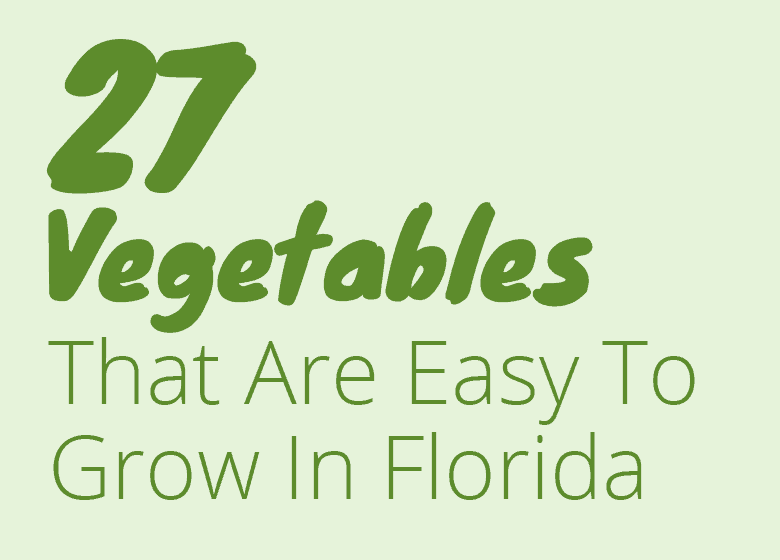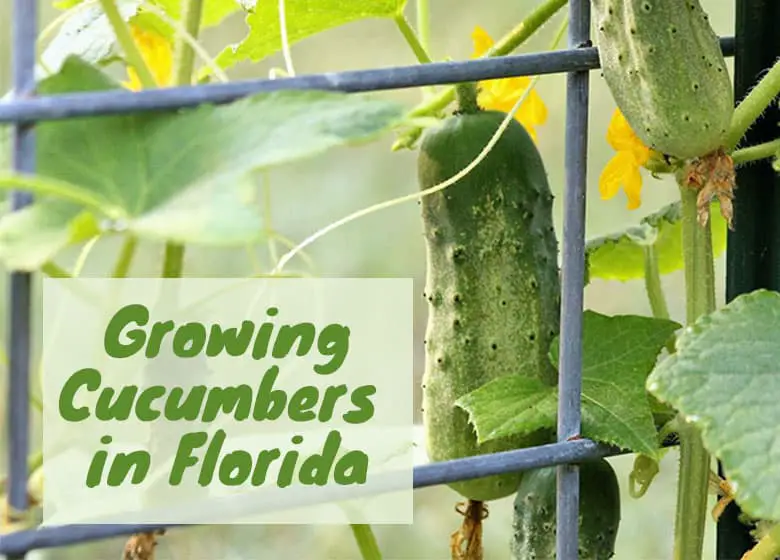
Will cucumbers grow well in Florida?
Yes, you can definitely grow cucumbers in Florida. Plant cucumbers in Florida during the cooler months, not in the hot summer. The best times are February to March and September to October. Choose a sunny, well-drained area with rich soil. We have had good luck with the Ashley, Boston pickling, and China jade varieties.
Growing cucumbers in Florida can be easy, you just have to plant the right variety at the right time and be willing to keep a watchful eye over your plant.
| Common Name | Cucumber |
| Botanical name | Cucumis sativus |
| Family | Cucurbitaceae |
| Size | 3-12 foot long vines (Bush types grow between 2-3 feet) |
| Sun Exposure | 6+ hours of direct Florida Sun |
| Florida Friendly Cucumber Varieties | Ashley, Bush Slicer, Boston Pickling, China Jade, Cherokee, Dasher II, Eureka, Sweet Success |
| When To Plant Cucumbers In Florida | North Florida(North of State Road 40) Aug & Feb, Central Florida(Between State Road 40 and State Road 70) Sep & Feb-Mar, South Florida(South of State Road 70)Sep – Jan |
When To Plant Cucumbers In Florida
It’s best to plant seeds in the garden in north Florida from August to September for a “fall garden” and then from February through March for a “Spring garden”.
In Central Florida, plant seeds directly into the garden in September for a “fall” garden and then you have from January through March to get your seed in the ground for a Spring garden.
Southern Florida has one planting season for cucumbers and that is from September up until January.
The timing of planting is very important when it comes to planting any kind of vegetable but the cucumber is especially sensitive to the weather.
It needs to be warm but not too warm.
This means that cucumbers will not grow well in intense summer heat. In north and central Florida we have two growing seasons for cucumbers. “Spring and Fall.”
If that’s what you want to call them.
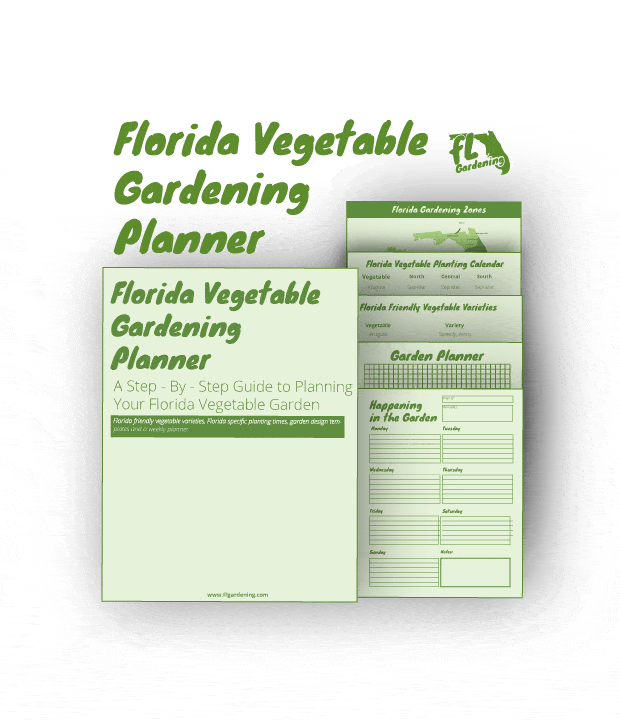
Get your Free Florida Vegetable Gardening Guide.
What varieties of cucumber grow well in Florida?
There are many different varieties of cucumber. You’ve got vining ones, bush-type ones, pickling ones, and slicing ones.
The first two traits, vining or bushing, refer to how the plant grows.
The last two, pickling or slicing, refer to how you will use the cucumber.
Slicing cucumbers are usually eaten in salads and things like that and the pickling kind are used for
Well…pickling.
The major difference between the two cucumbers is skin thickness.
Pickling cucumbers have much thinner skin compared to slicing cucumbers.
Not all slicing cucumbers are pickling cucumbers but all pickling cucumbers could be slicing cucumbers.
Below are some recommended varieties of cucumbers that will grow well in Florida if planted at the right time and cared for properly.
- Slicing cukes: Cherokee, China Jade, Dasher II, Sweet Success
- Pickling cukes: Adam, Ashley, Boston Pickling, Eureka
- Bush cukes: Bush Slicer(Slicing), Spacemaster(Slicing), Bush Champion(Slicing)
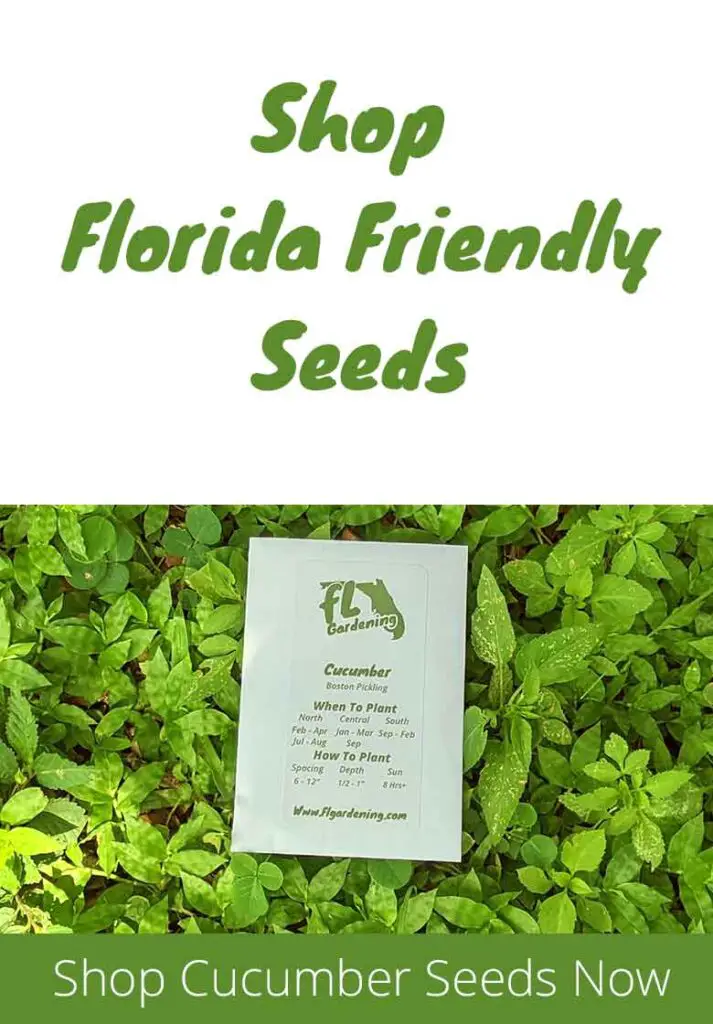
How much space do cucumbers take up?
It depends on whether you choose a vining or bush-type cucumber.
If you are low on space choose a bush-type cucumber. The Spacemaster variety is great for containers. This variety only needs a space of about 2′ x 2′ to grow.
Vining types will grow larger and produce more fruit. Vining type cucumbers (which are most types of cucumbers) will need to be grown on a trellis. This allows the cucumber plant to grow up something and will give you much better results, when you compared to just letting the plant grow on the ground.
Trellising your cucumber plant will protect it from some pests, and give it a better environment to help fight off diseases. A trellis will help improve airflow around you plant, this helps with the powdery mildew issue that cucumbers are susceptible to.
A trellis will also help you save space. Cucumber vines will grow around 8 feet or so long. So having them grow up instead of out is a much better option as far as maximizing space.
Growing Cucumbers in Pots
You can definitely grow cucumbers in a pot. A larger container will fare better than a smaller one because this will make watering your plants easier and help avoid root-bound plants.
Cucumbers are heavy feeders and a deeper soil will make for a healthier plant.
Bush-type cucumbers grow best in pots because of their compact size.
However, you can trellis vining cucumbers in pots also and we do this with other vining plants as well like melons and squash.
Planting large vining plants in pots and trellising them over a walkway is a great way to maximize space in the garden.
What kind of soil do cucumbers like?
A well-rounded mix that holds moisture but also has good airflow and drainage. My go-to soil mix is
- 40% Coco coir
- 40% Compost
- 20% perlite
- Worm castings
- Mykos
You can always substitute peat moss for coco coir. It is cheaper and easier to find (It can be found at most hardware stores) it’s farming practices however aren’t a sustainable model.
Mykos is A fungi additive and this makes a web of nutrient sharing goodness.
Worm castings for a good nutrient boost.
I’ve found good results with this mix and it’s what I use whenever I start a garden.
How much sun do cucumbers need?
Cucumbers need full sun. This means that at the very minimum, they need 6 hours to produce but 8+ is better.
When planning out your garden be mindful of how the sun moves a the seasons change. We moved into a new house about two years ago and I’m still surprised at how much our shade zones move.
It’s a really good idea to make a simple map of where you get full sun (6+ hours) in your yard year-round. Observe your yard on the winter solstice (December 21st or 22nd). This is the shortest day of the year and it marks when the sun is the furthest south it will be.
Do the same for your summer solstice (June 20th or 21st) when the sun is as far north as its going to go.
You will now know all of the sunniest and shadiest parts of your yard year round.
How do I water cucumbers?
Cucumbers are mostly made of water so they need to drink a lot. This means you will have to stay on top of watering them consistently.
The best way to tell when to water is to poke your finger in the dirt. If the top 1-2 inches of soil are dry, it’s time for a drink.
It’s also important that when you water that you try not to get the leaves wet.
Cucumbers are especially sensitive to certain kinds of mildew and keeping the leaves dry is an easy way to try and prevent that mildew from spreading.
Another best practice is to water in the early morning, this gives the rising sun a chance to dry out the cucumber’s leaves.
Having a thick layer of mulch also helps with watering.
We love to take the time and energy to set up an automated drip irrigation system. This saves you time in the garden but also ensures your plants never miss a watering.
How do I fertilize Cucumbers?
Cucumbers are fruit-producing plants which means that your fertilizer should be phosphorous and potassium focused. There are three numbers on most fertilizer bags, these are your N-P-K Values.
Nitrogen, phosphorous and potassium.
Nitrogen is used by plants to produce green, vegetative growth.
So feeding your cucumber a nitrogen-heavy fertilizer will result in a large, green and leafy plant but not much fruit.
Before planting you can choose to mix in a slow-release granular fertilizer or you can water your plants with a liquid soluble fertilizer.
I like water-soluble fertilizers because they are super easy to use.
Get something like a 5-10-10 and start fertilizing after your plant has matured to where it has a few sets of true leaves.
Begin to fertilize once every three weeks once you notice flowers appearing on your plant.
Common Diseases for cucumbers in Florida
The most serious problem for cucumbers is mildew. The leaves are easily attacked by powdery mildew and downy mildew.
The easiest way to deter these is to make sure the leaves have plenty of airflow, reducing overhead watering and making sure when you do water that it’s in the morning.
Our evening rains are sure to bring on mildew so be on the lookout after one of these.
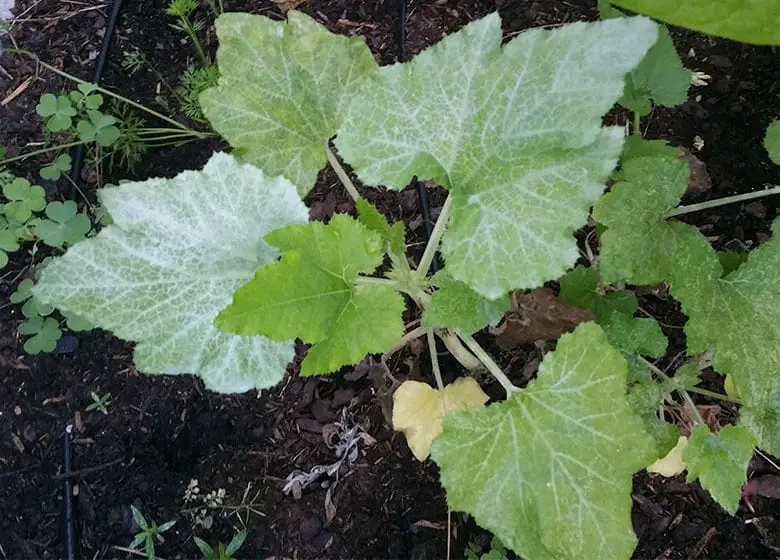
Neem oil can be used to kill powdery and downy mildew.
Neem oil is also harmful to insects, including the good ones.
So if you’re using neem oil be sure to spray in the evening hours when pollinators are less busy.
You can also use B.s.(Bacillus subtilis) it is safe for insects, pets and people but also less effective at killing the mildew organisms.
Synthetic products that contain chlorothalonil or mancozeb are fungicides that also kill and prevent mildew organisms.
Dasher II and Eureka are both the most disease-resistant varieties of cucumbers that will happily grow in Florida.
Common Florida Cucumber Pests
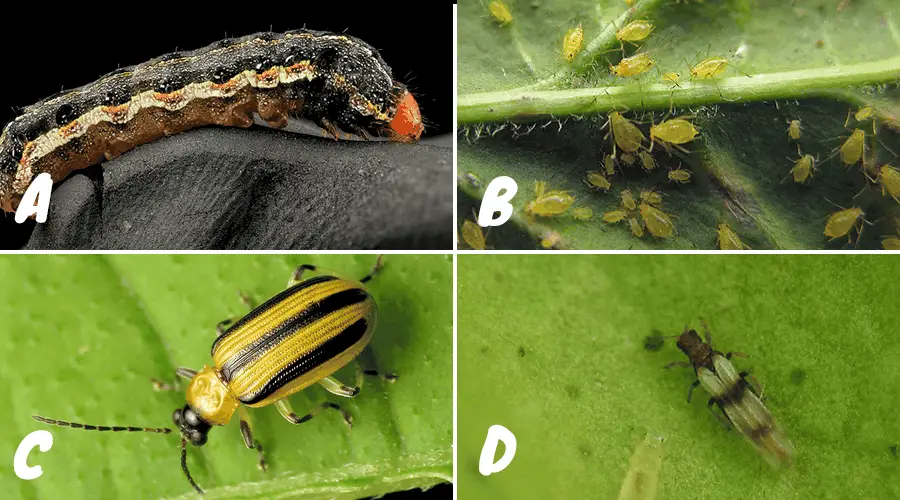
Aphids – Are a common pest on most vegetables in Florida. They are small round yellowish- green bodied insects. They usually live on the undersides of leaves.
They eat by taking their stupid pointy mouths and piercing your plant to suck it’s juices. Aphids secret a sugary substance called honeydew and it attracts molds and fungus. This is also an easy way for viruses to be spread. Neem oil will kill aphids that it comes into contact with. It’s best practice to apply weekly.
Whitefly – Are small fly looking bugs with powdery white wings. Whitflies harm your plant by also producing honeydew which invites mold and fungus to the party.They also have dumb pointy mouths that poke your plant and transmit viruses. They lay eggs on the underside of leaves.
Whiteflies are controlled with an insecticidal soap like Safer Soap.
Pickleworm – is a worm that is greenish- yellow with black spots. They turn into moths that have yellow wings that are bordered with brownish black color. These moths are active at night and lay eggs on new plant growth and flowers.
The worms damage flowers, decreasing fruit production and they can burrow into fruits as they form and even into your plant. Once an infestation has occurred treatment is near impossible.
It’s easier to stay on a prevention regime instead of a waiting to see them. Spray your plant weekly, once established with B.t.(Bacillus thuringiensis)
Cucumber beetles – There are a few common varieties of cucumber beetle that attack us here in Florida. The banded cucumber beetle is more common in southern Florida and has a green body with yellow bands across it. There is also the spotted cucumber beetle, which is more common in north Florida. This beetle has dark spots and a yellowish body. That last one we find here is the stripped cucumber beetle and is the least common of the three. This one has three black strips lengthwise on a yellow body.
These pests damage you plant by eating the leaves and stems. They can also pass along something that causes bacterial wilt.
Spinosad is a common insecticide that will control cucumber beetles.
If you don’t want to spray your plants with anything (even if it is organic) you can help control pests by planting beneficial plants that attract predators. Plants like sage, basil and marigolds will attract these predators.
Harvesting Cucumbers
When growing cucumbers you need to provide pollinators or else you will not have any fruit. These veggies make both a male and female flower and need to be pollinated
Cucumbers are ready to harvest usually 50-70 days after planting. The vegetables ripen at different times. This means that you will be harvesting more cucumbers every couple of days. Cucumbers do not ripen after you harvest them. This means you must pick cukes at the prime time. Ripe cukes have a firm green flesh. The size will vary depending on the variety you choose to grow. Slicing cucumbers can be 6-8 inches when ready for harvest and pickling cucumbers can be anywhere from 2-6 inches.
Use a pair of shears to snip the fruit from the plant.
Growing Cucumbers in Florida
- Our timing is different than other states. North Florida plants in August and February, Central Florida plants in September and February and South Florida can plant anywhere between September and January.
- Florida friendly varieties are: Cherokee(slicing), Dasher II(Slicing), Sweet Success(slicing) Adam(pickling), Eureka(pickling): Bush Slicer(Slicing bush type), Spacemaster(Slicing bush type), Bush Champion(Slicing bush type)
- You can certainly grow cucumber in pots, bush types are the easiest.
- You can trellis the vining type cucumbers to help with airflow and makes watering easier which are both good practices to prevent diseases.
- Cucumbers are heavy feeders so be sure to water them regularly.
- Fertilize cucumbers with something like a 5-10-10 fertilizer.
- Dasher II and Eureka are the most disease-resistant varieties. Be sure to keep an eye out for signs of powdery and downy mildew as they are the most common problems in cukes.
- There are a number of pests like aphids, whitefly, pickle worm, and cucumber beetles that attack your plants that can be controlled with Neem, B.t., B.s. and Spinosad.
You Might Also Be Interested In:
